

Blogging Prompts for Teacher Candidates. Why I Blog (And How You Can Too) Blogging has been both transformational and life-changing for me.
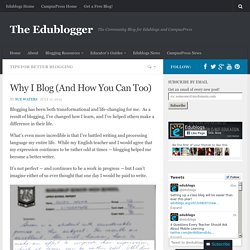
As a result of blogging, I’ve changed how I learn, and I’ve helped others make a difference in their life. What’s even more incredible is that I’ve battled writing and processing language my entire life. While my English teacher and I would agree that my expression continues to be rather odd at times — blogging helped me become a better writer. It’s not perfect — and continues to be a work in progress — but I can’t imagine either of us ever thought that one day I would be paid to write. My Actual English Report And yet my blogging story isn’t that unique. Which is why I’m often asked for advice by educators setting up their own personal or professional blog. This post is also a good example of how blogging changed the way I learn. UEB C@mpus - E-portfolio : valoriser sa formation et ses expériences. Itéractive. L’évaluation à l’aide d’un blogue comprend plusieurs aspects qui dépendent de l’utilisation que l’on fait de l’outil.
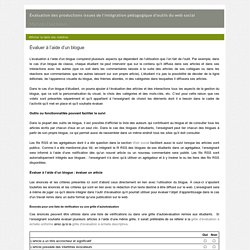
Par exemple, dans le cas d’un blogue de classe, chaque étudiant ne peut intervenir que sur le contenu qu’il diffuse dans ses articles et dans ses interactions avec les autres (que ce soit dans les commentaires laissés à la suite des articles de ses collègues ou dans les réactions aux commentaires que les autres laissent sur son propre article). L’étudiant n’a pas la possibilité de décider de la ligne éditoriale, de l’apparence visuelle du blogue, des thèmes abordés, ni des catégories dans lesquelles il diffusera ses articles.
Dans le cas d’un blogue d’étudiant, on pourra ajouter à l’évaluation des articles et des interactions tous les aspects de la gestion du blogue, que ce soit la personnalisation du visuel, le choix des catégories et des mots-clés, etc. Outils ou fonctionnalités pouvant faciliter le suivi. Edublogs Teacher Challenges. Uploading user and blog avatar. Your avatar is an online representation of you.
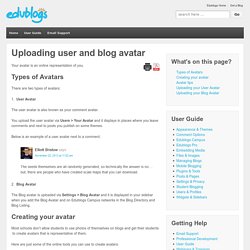
Types of Avatars There are two types of avatars: 1. User Avatar The user avatar is also known as your comment avatar. You upload the user avatar via Users > Your Avatar and it displays in places where you leave comments and next to posts you publish on some themes. Below is an example of a user avatar next to a comment. 2. engten.edublogs.org. Curriculum Corner – Introduction to blogging -Edublogs. Welcome to the world of blogging!
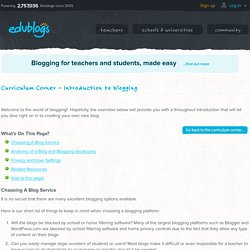
Hopefully, the overview below will provide you with a throughout introduction that will let you dive right on in to creating your own new blog. What’s On This Page? Choosing A Blog Service It is no secret that there are many excellent blogging options available. Here is our short list of things to keep in mind when choosing a blogging platform: Will the blogs be blocked by school or home filtering software? To help you compare the three largest blogging platforms, Edublogs, Blogger and WordPress, we’ve put together this comparison chart. Go back to the top of this page. Anatomy of a Blog and Blogging Vocabulary While different themes give blogs different looks, they all tend to have a similar layout. Here is a sample layout provided by buildinternet.com. Blogging Vocabulary Download our Crossword Puzzle that uses the following vocabulary words. - Great for all ages and student use!
Safe, secure, reliable and trusted by over a million users… -Edublogs. Edublogs MediaCore Library. Step 1: Set up your class blog. Tumblr in the Classroom by Julie Youngster on Prezi. HOW TO: Create a Group Tumblr Blog. This post originally appeared on the American Express OPEN Forum, where Mashable regularly contributes articles about leveraging social media and technology in small business. Welcome to the School of You. Step 2 – Set Up Your Blogging Rules and Guidelines. We’ve designed a series of nine steps, with how-to info, to help you with your class blogging.
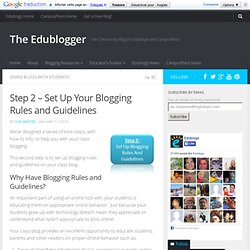
This second step is to set up blogging rules and guidelines on your class blog. Why Have Blogging Rules and Guidelines? An important part of using an online tool with your students is educating them on appropriate online behavior. Just because your students grew up with technology doesn’t mean they appreciate or understand what is/isn’t appropriate to post online. Your class blog provides an excellent opportunity to educate students, parents and other readers on proper online behavior such as: Types of identifying information that is appropriate in posts and/or comments e.g., What are your rules about use of last names, IM, images and personal information? L3 UEP Kid Lit › Log In. Mahara by Serge RICHARD on Prezi. Create and Manage Student Blogs in 5 Simple Steps. We’re seeing increasing numbers of educators use blogs as digital student portfolios, where students showcase their work and share their learning, throughout their school life.
Why? Studies have found that the effort of communicating to someone else forces you to pay more attention and learn more (Clive Thomspon).When students were asked to write for a real audience in another country, their essays had better organization and content than when they were writing for their teacher (Clive Thomspon).Digital student portfolios can be used for application to colleges, Universities or for applying for jobs.We all have increased motivation when we feel personal ownership. You see greater improvements in student learning and literacy skills when each student has their own student blog.
Blogs allow students to easily transfer the digital student portfolio to their own personal space as all standard blogging platforms allow you to easily transfer content between platforms using export/import. 1. 2. Safe and simple blogs for your students.